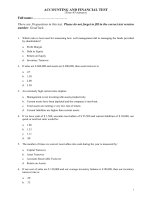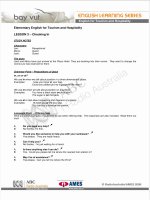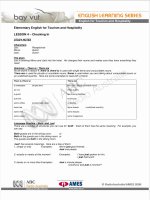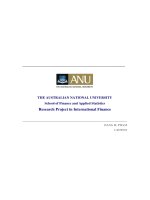Textiles and clothing
Bạn đang xem bản rút gọn của tài liệu. Xem và tải ngay bản đầy đủ của tài liệu tại đây (749.63 KB, 176 trang )
TheProjectGutenbergEBookofTextilesandClothing,byKateHeintzWatson
ThiseBookisfortheuseofanyoneanywhereatnocostandwith
almostnorestrictionswhatsoever.Youmaycopyit,giveitawayor
re-useitunderthetermsoftheProjectGutenbergLicenseincluded
withthiseBookoronlineatwww.gutenberg.net
Title:TextilesandClothing
Author:KateHeintzWatson
ReleaseDate:May19,2007[EBook#21534]
Language:English
***STARTOFTHISPROJECTGUTENBERGEBOOKTEXTILESANDCLOTHING***
ProducedbyStanGoodman,KarenDalrymple,andtheOnline
DistributedProofreadingTeamat
TextilesandClothing
BY
KATEHEINTZWATSON
GRADUATEARMOURINSTITUTEOFTECHNOLOGY
FORMERLYINSTRUCTORINDOMESTICART
LEWISINSTITUTE
LECTURERUNIVERSITYOFCHICAGO
AMERICANSCHOOLOFHOMEECONOMICSseal
CHICAGO
AMERICANSCHOOLOFHOMEECONOMICS
1907
COPYRIGHT1906,1907,BY
HOMEECONOMICSASSOCIATION
THELIBRARY
OF
HOMEECONOMICS
ACOMPLETEHOME-STUDYCOURSE
ONTHENEWPROFESSIONOFHOME-MAKINGANDARTOFRIGHT
LIVING;
THEPRACTICALAPPLICATIONOFTHEMOSTRECENTADVANCES
INTHEARTSANDSCIENCESTOHOMEANDHEALTH
PREPAREDBYTEACHERSOF
RECOGNIZEDAUTHORITY
FORHOME-MAKERS,MOTHERS,TEACHERS,PHYSICIANS,NURSES,
DIETITIANS,
PROFESSIONALHOUSEMANAGERS,ANDALLINTERESTED
INHOME,HEALTH,ECONOMYANDCHILDREN
TWELVEVOLUMES
NEARLYTHREETHOUSANDPAGES,ONETHOUSAND
ILLUSTRATIONS
TESTEDBYUSEINCORRESPONDENCEINSTRUCTION
REVISEDANDSUPPLEMENTED
AmericanSchoolofHomeEconomicsseal
CHICAGO
AMERICANSCHOOLOFHOMEECONOMICS
1907
COPYRIGHT,1907
BY
HOMEECONOMICSASSOCIATION
EnteredatStationers'Hall,London
AllRightsReserved.
AUTHORS
ISABELBEVIER,Ph.M.
ProfessorofHouseholdScience,UniversityofIllinois.AuthorU.S.
GovernmentBulletins,"DevelopmentofTheHomeEconomicsMovementin
America,"etc.
ALICEPELOUBETNORTON,M.A.
AssistantProfessorofHomeEconomics,SchoolofEduction,Universityof
Chicago;DirectoroftheChautauquaSchoolofDomesticScience.
S.MARIAELLIOTT
InstructorinHomeEconomics,SimmonsCollege;FormerlyInstructorSchoolof
Housekeeping,Boston.
ANNABARROWS
DirectorChautauquaSchoolofCookery;LecturerTeachers'College,Columbia
University,andSimmonsCollege;formerlyEditor"AmericanKitchen
Magazine;"Author"HomeScienceCookBook."
ALFREDCLEVELANDCOTTON,A.M.,M.D.
ProfessorDiseasesofChildren,RushMedicalCollege,UniversityofChicago;
VisitingPhysicianPresbyterianHospital,Chicago;Authorof"Diseasesof
Children."
BERTHAM.TERRILL,A.B.
ProfessorinHomeEconomicsinHartfordSchoolofPedagogy;AuthorofU.S.
GovernmentBulletins.
KATEHEINTZWATSON
FormerlyInstructorinDomesticEconomy,LewisInstitute;LecturerUniversity
ofChicago.
MARIONFOSTERWASHBURNE
Editor"TheMothers'Magazine;"LecturerChicagoFroebelAssociation;Author
"EverydayEssays,""FamilySecrets,"etc.
MARGARETE.DODD
GraduateMassachusettsInstituteofTechnology;TeacherofScience,Woodard
Institute.
AMYELIZABETHPOPE
WiththePanamaCanalCommission;FormerlyInstructorinPracticaland
TheoreticalNursing,TrainingSchoolforNurses,PresbyterianHospital,New
YorkCity.
MAURICELEBOSQUET,S.B.
DirectorAmericanSchoolofHomeEconomics;MemberAmericanPublic
HealthAssociationandAmericanChemicalSociety.
CONTRIBUTORSANDEDITORS
ELLENH.RICHARDS
Author"CostofFood,""CostofLiving,""CostofShelter,""FoodMaterialsand
TheirAdulteration,"etc.,etc.;ChairmanLakePlacidConferenceonHome
Economics.
MARYHINMANABEL
AuthorofU.S.GovernmentBulletins,"PracticalSanitaryandEconomic
Cooking,""SaleFood,"etc.
THOMASD.WOOD,M.D.
ProfessorofPhysicalEducation,ColumbiaUniversity.
H.M.LUFKIN,M.D.
ProfessorofPhysicalDiagnosisandClinicalMedicine,UniversityofMinnesota.
OTTOFOLIN,Ph.D.
SpecialInvestigator,McLeanHospital,Waverly,Mass.
T.MITCHELLPRUDDEN,M.D.,LL.D.
Author"DustandItsDangers,""TheStoryoftheBacteria,""DrinkingWater
andIceSupplies,"etc.
FRANKCHOUTEAUBROWN
Architect,Boston,Mass.;Authorof"TheFiveOrdersofArchitecture,""Letters
andLettering."
MRS.MELVILDEWEY
SecretarLakePlacidConferenceonHomeEconomics.
HELENLOUISEJOHNSON
ProfessorofHomeEconomics,JamesMillikanUniversity,Decatur.
FRANKW.ALLIN,M.D.
InstructorRushMedicalCollege,UniversityofChicago.
MANAGINGEDITOR
MAURICELEBOSQUET,S.B.
DirectorAmericanSchoolofHomeEconomics.
BOARDOFTRUSTEES
OFTHEAMERICANSCHOOLOFHOMEECONOMICS
MRS.ARTHURCOURTENAYNEVILLE
PresidentoftheBoard.
MISSMARIAPARLOA
FounderofthefirstCookingSchoolinBoston;Authorof"HomeEconomics,"
"YoungHousekeeper,"U.S.GovernmentBulletins,etc.
MRS.MARYHINMANABEL
Co-workerinthe"NewEnglandKitchen,"andthe"RumfordFoodLaboratory;"
AuthorofU.S.GovernmentBulletins,"PracticalSanitaryandEconomic
Cooking,"etc.
MISSALICERAVENHILL
SpecialCommissionersentbytheBritishGovernmenttoreportontheSchools
ofHomeEconomicsintheUnitedStates;FellowoftheRoyalSanitaryInstitute,
London.
MRS.ELLENM.HENROTIN
HonoraryPresidentGeneralFederationofWoman'sClubs.
MRS.FREDERICW.SCHOFF
PresidentNationalCongressofMothers.
MRS.LINDAHULLLARNED
PastPresidentNationalHouseholdEconomicsAssociation;Authorof"Hostess
ofTo-day."
MRS.WALTERMcNABMILLER
ChairmanofthePureFoodCommitteeoftheGeneralFederationofWoman's
Clubs.
MRS.J.A.KIMBERLY
VicePresidentofNationalHouseholdEconomicsAssociation.
MRS.JOHNHOODLESS
GovernmentSuperintendentofDomesticSciencefortheprovinceofOntario;
FounderOntarioNormalSchoolofDomesticScience,nowtheMacDonald
Institute.
DRESSMAKINGINMEXICO
DRESSMAKINGINMEXICO
CONTENTS
PRIMITIVEMETHODS
WEAVING
FIBERS
COTTON
WOOL
FLAX
SILK
MODERNMETHODS
WEAVING
WEAVES
BLEACHINGANDDYEING
PRINTING
FINISHING
COTTONGOODS
LINENS
WOOLENSANDWORSTEDS
SILKS
NAMESOFFABRICS
BIBLIOGRAPHYONTEXTILES
HANDSEWING
ORNAMENTALSTITCHES
HEMS
TUCKSANDSEAMS
PLACKETS
SEWINGONBANDS
FASTENINGS
PATCHING
DARNING
MITERINGEMBROIDERY,JOININGLACE
3
14
29
29
37
43
53
59
69
72
78
81
83
85
86
88
90
94
103
107
114
123
128
135
138
141
149
155
158
MACHINESEWING
162
DRESSMAKING
167
PATTERNS
171
MAKINGSEVEN-GOREDSKIRT
172
MAKINGSHIRTWAISTS
182
LINEDWAIST
186
SLEEVES
194
COLLARS
198
SEAMLESSYOKES
200
PRESSING
201
CONSTRUCTIONANDORNAMENTINDRESS
203
ORNAMENTOFTEXTILES
212
COLOR
214
CHILDREN'SCLOTHES
216
CAREOFCLOTHING
219
CLEANING
221
REPAIRING
225
BIBLIOGRAPHYONSEWINGANDDRESSMAKING
229
REFERENCES:HISTORYOFCOSTUME;ORNAMENTANDDESIGN 234
PROGRAMFORSUPPLEMENTALSTUDY
236
INDEX
241
"THETHREADOFLIFE
"THETHREADOFLIFE"
SpinningwiththeDistaffandSpindle.FromaPainting.
TEXTILESANDCLOTHING
OriginofTextileArts
Spinningandweavingareamongtheearliestarts.Inthetwistingoffibers,hairs,
grasses,andsinewsbyrollingthembetweenthethumbandfingers,palmsofthe
hands,orpalmsandnakedthigh,wehavetheoriginalofthespinningwheeland
thesteam-drivencottonspindle;intheroughestplaitingwehavethefirsthintof
thefinest woven cloth.Theneedofsecuringthingsorotherwisestrengthening
them then led to binding, fastening, and sewing. The wattle-work hut with its
roofofinterlacedboughs,theskinssewnbyfineneedleswithentrailsorsinews,
themattedtwigs,grasses,andrushesareallthecrudebeginningsofanartwhich
tellsofthesettledlifeofto-day.
PrimitiveMethods
Nothing is definitely known of the origin of these arts; all is conjecture. They
doubtless had their beginning long before mention is made of them in history,
but these crafts—spinning and weaving—modified and complicated by
inventionsand,inmoderntimestransferredlargelyfrommantomachine,were
distinctivelywoman'semployment.
The veryprimitivetype of spinning,wherenospindlewasused,wastofasten
the strands of goats' hair or wool to a stone which was twirled round until the
yarnwassufficientlytwistedwhenitwaswounduponthestoneandtheprocess
repeatedoverandover.
ITALIANWOMANSPINNINGFLAX
ITALIANWOMANSPINNINGFLAX
SpindleandDistaff.
FromHullHouseMuseum.(InThisSeriesofPicturestheSpinnersandWeavers
AreinNativeCostume.)
RUSSIANSPINNING
RUSSIANSPINNING
FlaxHeldonFrame,LeavingBothHandsFreetoManagetheThreadand
Spindle.
FromHullHouseMuseum.
SpinningwiththeSpindle
Thenextmethodoftwistingyarnwaswiththespindle,astraightstickeightto
twelveincheslongonwhichthethreadwaswoundaftertwisting.Atfirstithad
acleftorsplitinthetopinwhichthethreadwasfixed;laterahookofbonewas
addedtotheupperend.ThespindleisyetusedbytheNorthAmericanIndians,
theItalians,andintheOrient.Thebunchofwoolorflaxfibersisheldintheleft
hand; with the right hand the fibers are drawn out several inches and the end
fastenedsecurelyintheslitorhookonthetopofthespindle.Awhirlingmotion
is given to the spindle on the thigh or any convenient part of the body; the
spindleisthendropped,twistingtheyarn,whichiswoundontheupperpartof
the spindle. Another bunch of fibers is drawn out, the spindle is given another
twirl,theyarniswoundonthespindle,andsoon.
SpindleWhorl
Aspindlecontainingaquantityofyarnwasfoundtorotatemoreeasily,steadily
and continue longer than an empty one, hence the next improvement was the
additionofawhorlatthebottomofthespindle.Thesewhorlsarediscsofwood,
stone,clay,ormetalwhichkeepthespindlesteadyandpromoteitsrotation.The
processineffectispreciselythesameasthespinningdonebyourgrandmothers,
only the spinning wheel did the twisting and reduced the time required for the
operation.
SPINNINGWITHCRUDEWHEELANDDISTAFF
SPINNINGWITHCRUDEWHEELANDDISTAFF
DistaffThrustIntotheBelt.
"GOSSIP"INTHEOLDENTIMES
"GOSSIP"INTHEOLDENTIMES
COLONIALWOOLWHEEL
COLONIALWOOLWHEEL
TheLargeWheelRevolvedbyHandThusTurningtheSpindleandTwistingthe
Yarn,WhichIsThenWoundontheSpindle;IntermittentinAction.
COLONIALFLAXWHEEL
COLONIALFLAXWHEEL
WorkedbyaFootTreddle;DistaffontheFrameoftheWheel;"Fliers"onthe
Spindle,ContinuousinAction;CapacitySevenTimesThatofHandSpindle.
DUTCHWHEEL
DUTCHWHEEL
SpinnerSitsinFrontoftheWheel—SpinningFlaxatHullHouse.
Distaff
Laterthedistaffwasusedforholdingthebunchofwool,flax,orotherfibers.It
wasashortstickononeendofwhichwaslooselywoundtherawmaterial.The
otherendofthedistaffwasheldinthehand,underthearmorthrustinthegirdle
ofthespinner.Whenheldthus,onehandwasleftfreefordrawingoutthefibers.
GraphicDiagramShowingTimeDuringwhichDifferentMethodsofSpinning
HasBeenUsed.
GraphicDiagramShowingTimeDuringwhichDifferentMethodsof
SpinningHasBeenUsed.
WheelSpinning
Onthesmallspinningwheelthedistaffwasplacedintheendofthewheelbench
in front of the "fillers"; this left both hands free to manage the spindle and to
drawoutthethreadsofthefibers.
SYRIANSPINNING
SYRIANSPINNING
SpinnerSitsontheFloor,WheelTurnedbyaCrank;SpindleHeldinPlaceby
TwoMuttonJointsWhichContainEnoughOilforLubrication.AtHullHouse.
Theflaxspinningwheel,workedbymeansofatreadle,wasinventedintheearly
partofthesixteenthcenturyandwasagreatimprovementuponthedistaffand
spindle. This it will be seen was a comparatively modern invention. The rude
wheel usedbythenativesofJapanandIndiamayhavebeentheprogenitorof
theEuropeanwheel,asaboutthistimeintercoursebetweentheEastandEurope
increased. These wheels were used for spinning flax, wool, and afterwards
cotton,untilHargreaves'inventionsupersededit.
WEAVING
PUEBLOWOMANWORKINGHEDDLEINWEAVINGABELT
PUEBLOWOMANWORKINGHEDDLEINWEAVINGABELT
Someone has said that "weaving is the climax of textile industry." It is an art
practiced by all savage tribes and doubtless was known before the dawn of
history.Theartisbutadevelopmentofmat-makingandbasketry,usingthreads
formedormadebyspinninginplaceofcoarserfilaments.
ANAVAJOBELTWEAVER
ANAVAJOBELTWEAVER
ZUNIWOMANWEAVINGCEREMONIALBELT
ZUNIWOMANWEAVINGCEREMONIALBELT
TheHeddle
Inthebeginningoftheartthewarpthreadswerestretchedbetweenconvenient
objects on the ground or from horizontal supports. At first the woof or filling
threadswerewovenbackandforthbetweenthewarpthreadsasindarning.An
improvementwasthedevicecalledthe"heald"or"heddle,"bymeansofwhich
alternatewarpthreadscouldbedrawnawayfromtheothers,makinganopening
throughwhichthefillingthreadcouldbepassedquickly.Oneformoftheheddle
wassimplyastraightstickhavingloopsofcordorsinewthroughwhichcertain
ofthewarpthreadswererun.Anotherformwasaslottedframehavingopenings
or"eyes"intheslats.Thiswascarvedfromonepieceofwoodorothermaterial
or made from many. Alternate warp threads passed through the eyes and the
slots.Byraisingorloweringtheheddleframe,anopeningwasformedthrough
which the filling thread, wound on a rude shuttle, was thrown. The next
movement of the heddle frame crossed the threads over the filling and made a
newopeningforthereturnoftheshuttle.Atfirstthefillingthreadwaswoundon
a stick making a primitive bobbin. Later the shuttle to hold the bobbin was
devised.
PRIMITIVEHEDDLES
PRIMITIVEHEDDLES
NAVAJOLOOM
NAVAJOLOOM
OneontheEarliestTypesofLooms.AtHullHouse.
SIMPLECOLONIALLOOM
SIMPLECOLONIALLOOM
TheReed
Beforethe"reed"wasinvented,thefillingthreadsweredrawnevenlyintoplace
bymeansofarudecombanddrivenhome bysword-shapedpieceofwoodor
"batten."Thereedaccomplishedallthisatonetime.
AJAPANESELOOM.
AJAPANESELOOM.
AFOURHARNESSHANDLOOM
AFOURHARNESSHANDLOOM
WeavingLinenintheMountainsofVirginia.(PhotographbyC.R.Dodge).
TYPICALCOLONIALHANDLOOM
TYPICALCOLONIALHANDLOOM
TwoHarnessesinUse;WeavingWoolatHullHouse.
DefinitionofaLoom
ItisprobablethattheEuropeanloomswerederivedfromthoseofIndiaasthey
seemtobemadeonthesameprinciple.Fromcrudebeginnings,thehandloom
ofourgrandmothers'timedeveloped.Aloomhasbeendefinedasamechanism
whichaffectsthefollowingnecessarymovements:
1.Theliftingofthehealdstoformanopening,orshed,orracefortheshuttleto
passthrough.
DIAGRAMOFAHANDLOOM
DIAGRAMOFAHANDLOOM
A—WarpBeam;B—ClothBeam;DD—LeesRods;H—Harness;T—Treddle.
2.Thethrowingoftheweftorfillingbymeansofashuttle.
3.Thebeatingupoftheweftleftintheshedbytheshuttletotheclothalready
formed. This thread may be adjusted by means of the batten, needle, comb, or
anyseparatedevicelikethereed.
4&5.Thewindinguportakingupoftheclothasitiswovenandthelettingoff
ofthewarpastheclothistakenup.
SWEDISHHANDLOOM
SWEDISHHANDLOOM
NorwegianWomanWeavingLinenatHullHouse.
DIAGRAMOFTHEWORKINGPARTSOFALOOM.
DIAGRAMOFTHEWORKINGPARTSOFALOOM.
S—Shuttleforcarryingthewoof;R—Reedforbeatingupthewoof;H—Frame
holdingheddles,withpullies(P)makingtheharness;T—Treddlesformoving
theharness.
ColonialLoom
No essential changes have been made since our grandmothers made cloth a
hundredyearsago.The"harnesses"movepartofthewarpnowup,nowdown,
andtheshuttlecarriestheweftfromsidetosidetobedrivenhomebythereeds
tothewovencloth.Ourgrandmothersdidalltheworkwithswiftmovementsof
hands and feet. The modern weaver has her loom harnessed to the electric
dynamoandmovesherfingersonlytokeepthethreadsinorder.Ifshewishesto
weave a pattern in the cloth, no longer does she pick up threads of warp now
here, now there, according to the designs. It is all worked out for her on the
loom.Eachthreadwithalmosthumanintelligencesettlesautomaticallyintoits
appointedplace,andtheweaverisonlyamachinetender.
FLYSHUTTLEHANDLOOM.
FLYSHUTTLEHANDLOOM.
ThePullingoftheReedAutomaticallyThrowstheShuttleBackandForthand
WorkstheHarness,MakingaShedattheProperTime.
PrimitiveFabrics
Notextilesofprimitivepeoplewereeverwovenin"pieces"or"bolts"ofyards
andyardsinlengthtobecutintogarments.Theclothwasmadeofthesizeand
shapetoservetheparticularpurposeforwhichitwasdesigned.Themat,robe,
or blanket had tribal outlines and proportions and was made according to the
materials and the use of common forms that prevailed among the tribes. The
designs were always conventional and sometimes monotonous. The decoration
never interfered with its use. "The first beauty of the savage woman was
uniformity which belonged to the texture and shape of the product." The
uniformity in textile, basketry, or pottery, after acquiring a family trait, was
never lost sight of. Their designs were suggested by the natural objects with
whichtheywerefamiliar.
FIBERS
PICKINGCOTTON.
PICKINGCOTTON.
FromDepartmentofAgricultureBulletin,"TheCottonPlant."
Both the animal and vegetable kingdoms furnish the materials for clothing as
wellasforallthetextilesusedinthehome.Thefleeceofsheep,thehairofthe
goatandcamel,silk,furs,andskinsarethechiefanimalproducts.Theprincipal
vegetablefibersarecotton,flax,ramie,jute,andhemp.
ChiefFibers
Cottonlinen,wool,andsilkhaveheretoforeformedthefoundationofalltextiles
andaretheprincipalfibersusedforclothingmaterials.RamieorChinagrassand
pineapple fibers are sometimes used as adulterants in the manufacture of silk.
Whenwovenalone,theygivesoftsilkytextilesofgreatstrengthandbeauty.
COTTON
PRODUCTIONOFCOTTON
PRODUCTIONOFCOTTON
Cotton is now our chief vegetable fiber, the yearly crop being over six billion
pounds, of which the United States raises three-fourths. Texas is the largest
producer,followedbyGeorgia,Alabama,andMississippi.Theremainderofthe
worldsupplycomeschieflyfromIndia,Egypt,Russia,andBrazil.TheHindoos
werethefirstancientpeopletomakeextensiveuseofthecottonfiber.Notuntil
theinvention ofthe cottonginbyEliWhitneyin1794didthecottonbeginto
reach its present importance. Only four or five pounds of the fiber could be
separatedbyhandfromtheseedbyaweek'slabor.Themodernsawginsturnout
overfivethousandpoundsdaily.
NativeHome
Cotton is the white downy covering of the seed of several special of cotton of
cottonplant.Itisanativeofmanypartsoftheworld,beingfoundbyColumbus
growing in the West Indies and on the main land, by Cortez in Mexico, and
PizarroinPeru.
COTTONFIBERATTACHEDTOSEEDCOTTONFIBERATTACHED
TOSEED
SeaIslandCotton
The value of cotton depends upon the strength, and evenness of the fiber. In
ordinary cotton the individual fiber is about an inch in length. The sea island
cotton grown chiefly on the islands off the coast of Georgia, Carolina, and
Floridaisthemostvaluablevariety,havingafinefiber,oneandone-halftotwo
inchesinlength.SomeoftheEgyptiancottonbelongstothisspecies.Seaisland
cotton is used chiefly for fine laces, thread and knit goods and for the finest
lawnsandmuslins.
UplandCotton
The short fiber or upland cotton is the most common and useful variety. It is
grown in Georgia, North and South Carolina and Alabama. Texas cotton is
similartoupland,butsometimesisharshwithshorterfiber.Gulfcottonoccupies
apositionbetweenuplandandseaislandcotton.
UPLANDCOTTONPLANTWITHFULLYDEVELOPEDBOLES
UPLANDCOTTONPLANTWITHFULLYDEVELOPEDBOLES
FromBulletinNo.31,GeorgiaExperimentStation.
COTTONBOLEFULLYDEVELOPED
COTTONBOLEFULLYDEVELOPED
FromYearBookoftheDepartmentofAgriculture,1903.
BOLEOPENED,COTTONREADYFORPICKING
BOLEOPENED,COTTONREADYFORPICKING
YearBookof1903.
TheBrazilianandPeruviancottonyieldsalongstapleandissometimesusedto
adulteratesilkandotherfibers.Somevarietiesofthiscottonareharshandwooly
andareprizedforuseinmixingwithwool.
NankinCotton
The Nankin cotton grown in China and India and in the southwestern part of
Louisiana is characterized by its yellow color. It is used in weaving cloth of
various kinds in the "fireside industries" which have become popular in the
UnitedStatesandEngland.
COTTONFIBERS
COTTONFIBERS
AA—UnripeFibers;BB—Half-ripeFibers;CC—RipeFibers.
SpinningQualities
Very fine yarn can be spun from cotton because of the spiral character of the
fibers. This twist of the fibers is peculiar to cotton, being present in no other
animalorvegetablefiber.Onaccountofthistwist,cottonclothsaremuchmore
elasticincharacterthanthosewovenfromlinen,thefibersofwhicharestiffand
straight.
After the removal of the seed, no other fiber is so free from impurities—5 per
cent is the loss sustained by cleaning and bleaching. In its natural condition,
cotton will not dye readily because of a waxy substance on the surface of the
fibers.Thismustberemovedbywashing.
PickingandGinning
Cottonshouldbepickedonlywhenitisfullyripewhenthepodsarefullyburst
and the fibers expanded. The unripe fiber is glassy, does not attain its full
strength and resists the dye. After picking, the cotton is sent to the ginning
factory to have the seed removed. It is then pressed into bales by hydraulic
presses,fivehundredpoundsbeingthestandardbaleintheUnitedStates.
COTTONBALES
COTTONBALES
PhysicalCharacteristics
Purified bleached cotton is nearly pure cellulose. It resists the action of alkalis
well,butisharmedbyhot,strongacids,orifacidisallowedtodryonthefabric.
Itisnotharmedbyhightemperature,andsomaybeironedwithahotiron.
WOOLFIBERANDSUBSTITUTES
WOOLFIBERANDSUBSTITUTES
1.SouthAmericanWool;2.NoilfromtheSame;3.TangledWaste;4.Waste
CombedOut;5.LapWaste;6.Shoddy.
WOOL
CharacterofFiber
Woolisthemostimportantanimalfiber.Strictlyspeakingthenameappliesonly
to the hairy covering of sheep, but the hair of certain goats and of camels is
generallyclassifiedunderthesameterms.Thewoolfiberisdistinguishedbyits
scale-like surface which gives it its felting and spinning properties. Hair as
distinguishedfromwoolhaslittleornoscalystructurebeingingeneralasmooth
filamentwithnofeltingpropertiesandspinningonlywithgreatdifficulty.Furis
theundergrowthfoundonmostfur-bearinganimalsandhasinamodifiedway
thescalystructureandfeltingpropertiesofwool.
MICROSCOPICAPPEARANCEOFWOOLFIBERS
MICROSCOPICAPPEARANCEOFWOOLFIBERS
ValueforClothing
Thegreatvalueofwoolasafiberliesinthefactthatitisstrong,elastic,soft,
verysusceptibletodyestuffsandbeingwoven,furnishesagreatnumberofair
spaces,renderingclothingmadefromitverywarmandlight.
QualityofWool
Climate,breed,andfoodinfluencethequalityofthewool.Wherethepasturage
isbarrenandrocky,thewoolisapttobecoarse.
MERINORAMS
MERINORAMS
TheVarietyofSheepGivingtheFinestWool.
VarietiesofSheep
Therearesupposedtobeaboutthirtydistinctvarietiesofsheep,nearlyhalfof
which are natives of Asia, one-third of Africa, and only four coming from
Europe,andtwofromAmerica.Woolisdividedintotwogeneralclasses—long
andshortstaple,accordingtotheaveragelengthoffiber.Thelongfiberwoolis
commonlycarded,combedandspunintoworstedyarn.Theshortfiberisusually
carded and spun into woolen yarn. The short fiber obtained in combing long
staplewooliscalled"noil."Itisusedforwoolens.
GoatWools
Alpaca,VicunaandLlamawoolsareobtainedfromanimalswhicharenativeto
themountainsofPeruandChile.TheAngoragoat,originallyfromAsiaMinor,
furnishes the mohair of commerce. This fiber does not resemble the hairs of
common goats in any respect. It is a very beautiful fiber of silky luster, which
constitutesitschiefvalue.
ANGORAGOATS
ANGORAGOATS
Fur
The fur of beavers and rabbits can be and is used in manufacture, either spun
into yarn or made into felt. The fibers of both animals enter largely into the









